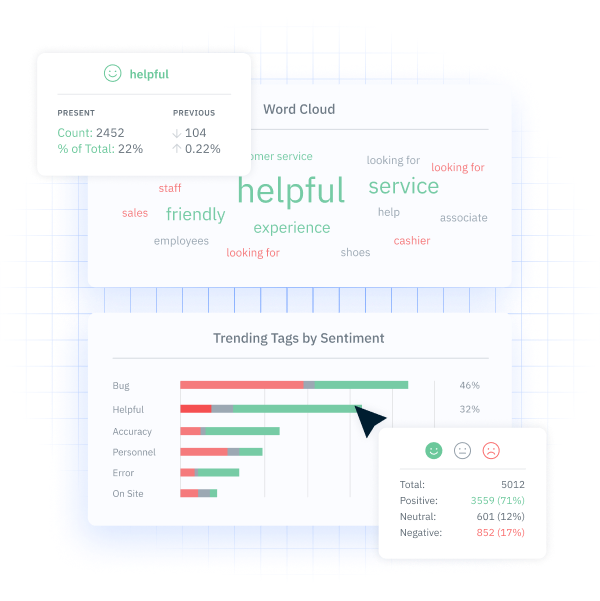Text Mining: Everything You Need to Know
Text mining is the process of extracting useful information from large amounts of text using computational techniques. It involves analyzing and transforming unstructured text into structured data for insights.
In today’s data-driven world, businesses generate and accumulate vast amounts of text data from various sources, including customer feedback, social media, emails, and internal documents. However, extracting meaningful insights from this unstructured data can be challenging.
This is where text mining comes into play. By transforming unstructured text data into valuable information, text mining enables businesses to uncover hidden trends, sentiments, and relationships within the data. This process is crucial for making informed decisions, enhancing the customer experience, and maintaining a competitive edge.
What is Text Mining?
Text mining, also known as text data mining, is the process of analyzing unstructured text data to extract meaningful patterns and insights. This process involves using techniques from natural language processing (NLP), machine learning, and statistics to transform textual information into a structured format that can be easily analyzed. By doing so, organizations can uncover hidden trends, sentiments, and relationships within the data, which can inform strategic decisions and drive business growth.
Text Mining Examples and Use Cases
Consider a business interested in contact center optimization. They could implement text mining to enhance operations and improve customer satisfaction. The center can identify common customer issues and frequently asked questions by analyzing transcripts of customer service calls, emails, and chat interactions.
From those insights, the contact center can pinpoint areas where agents need additional training and identity processes that require streamlining. For instance, text mining might reveal that a significant number of calls were related to the same few technical issues. This discovery can lead to bug fixes as well as a more comprehensive knowledge base for agents, which can significantly reduce call resolution times.
Why is Text Mining Important?
In an era where data is considered the new oil, the ability to analyze and derive insights from unstructured text data is invaluable. Text mining is important for several reasons:
1. Extracting Valuable Insights: Text mining enables businesses to sift through large volumes of unstructured text data and extract valuable insights. Whether it’s customer feedback, social media comments, or internal documents, these insights can reveal trends, sentiments, and patterns that are crucial for strategic decision-making.
2. Enhancing Customer Experience: By analyzing customer feedback and sentiment, companies can better understand their customers’ needs, preferences, and pain points. This understanding allows businesses to tailor their products, services, and interactions to meet customer expectations, thereby enhancing overall customer satisfaction and loyalty.
3. Improving Operational Efficiency: Text mining can help identify inefficiencies and areas for improvement within an organization. For example, analyzing support tickets and emails can reveal common issues that need addressing, enabling companies to streamline their operations and improve service quality.
4. Supporting Data-Driven Decision Making: Text mining transforms unstructured data into structured data that can be easily analyzed and visualized. This transformation supports data-driven decision-making processes by providing actionable insights that are grounded in actual data rather than intuition or guesswork.
5. Gaining Competitive Advantage: By leveraging text mining, businesses can stay ahead of the competition by quickly identifying market trends, customer preferences, and emerging issues. This proactive approach allows companies to adapt and innovate faster than their competitors.
6. Enabling Predictive Analytics: Text mining can also be used in conjunction with predictive customer analytics to forecast future trends and behaviors. For instance, sentiment analysis of customer reviews can predict future product success, while topic modeling can identify emerging trends in customer interests.
Difference Between Text Mining and Text Analytics
While text mining and text analytics are often used interchangeably, they have distinct focuses and processes. Understanding the difference between the two can help businesses leverage the right techniques for their specific needs.
Text Mining
Text mining is the process of discovering patterns and extracting useful information from unstructured text data. It involves transforming text into a structured format, which can then be analyzed. The primary goal of text mining is to uncover hidden insights and trends that are not immediately obvious.
Key Components of Text Mining:
- Data Collection: Gathering text data from various sources such as websites, social media, emails, and internal documents.
- Preprocessing: Cleaning and preparing the text data by removing noise, normalizing text, and tokenizing.
- Transformation: Converting text into a structured format using techniques like vectorization.
- Analysis: Applying NLP, machine learning, and statistical methods to identify patterns and extract insights.
Text Analytics
Text analytics is the application of text mining techniques to solve specific business problems. It involves analyzing the structured data produced by text mining to gain actionable insights and inform decision-making. Text analytics often integrates text mining results with other types of data analysis to provide a comprehensive understanding of the data.
Key Components of Text Analytics:
- Integration: Combining text data with other data sources to provide a holistic view.
- Visualization: Presenting the findings in a comprehensible format using graphs, charts, and dashboards.
- Reporting: Generating reports that highlight key insights and recommendations.
- Actionable Insights: Using the analyzed data to inform business strategies and decisions.
Consider a company analyzing customer reviews to improve its products. Text mining would involve processing the reviews to identify common themes and sentiments. Text analytics would then take these findings and integrate them with sales data to understand the impact of customer feedback on product performance and make strategic recommendations.
How Text Mining Works
Text mining involves several steps that transform unstructured text data into structured data, which can then be analyzed to extract meaningful insights. Here is a detailed look at the key steps involved in the text mining process:
1. Data Collection: The first step in text mining is gathering text data from various sources. This can include customer feedback, social media posts, emails, online reviews, internal documents, and more. The data collection process may involve web scraping, database extraction, or API integration to aggregate the text data into a single repository.
2. Preprocessing: Once the data is collected, it needs to be cleaned and prepared for analysis. Preprocessing involves several sub-steps:
- Tokenization: Splitting the text into individual words or tokens.
- Stop Words Removal: Eliminating common words (e.g., “and”, “the”, “is”) that do not contribute to the analysis.
- Stemming and Lemmatization: Reducing words to their root form (e.g., “running” to “run”).
- Normalization: Converting text to a standard format, such as lowercase all words and removing punctuation and special characters.
3. Transformation: After preprocessing, the text needs to be transformed into a structured format. This often involves:
- Vectorization: Converting text into numerical vectors that represent the frequency or presence of words or phrases. Common techniques include Term Frequency-Inverse Document Frequency (TF-IDF) and word embeddings like Word2Vec.
- Feature Extraction: Identifying and extracting relevant features from the text that can be used in subsequent analysis.
4. Analysis: With the structured data in hand, various analytical techniques are applied to extract insights:
- Natural Language Processing (NLP): Techniques such as named entity recognition (NER), part-of-speech tagging, and dependency parsing to understand the structure and meaning of the text.
- Machine Learning: Applying algorithms to classify, cluster, and predict outcomes based on the text data. Common methods include sentiment analysis, topic modeling, and text classification.
- Statistical Analysis: Using statistical methods to identify patterns, correlations, and trends within the text data.
5. Visualization: The final step is to present the findings in an easily understandable format. Visualization tools and techniques are used to create graphs, charts, word clouds, and dashboards that highlight key insights and trends. Effective visualization helps stakeholders quickly grasp the results and make informed decisions.

Text Mining Best Practices
Implementing text mining effectively requires adherence to several best practices to ensure accurate, actionable insights and optimal outcomes. By following these best practices, organizations will be set up for success in utilizing text mining effectively.
1. Define Clear Objectives
Set clear, specific goals for what you want to achieve with text mining. Whether it’s enhancing customer experience, identifying market trends, or detecting fraud, having well-defined objectives will guide your project and measure success.
2. Select the Right Tools
Choose tools and software that align with your project requirements and team expertise. It is important to find text mining software that has all the necessary features to complete the projects you are working on.
3. Data Quality and Diversity
Ensure that the text data you collect is relevant, high-quality, and diverse, drawing from sources such as customer feedback, social media, emails, and internal documents. Gathering data from multiple sources can decrease the chances of voluntary response bias, or other biases that can damage the integrity of your data. Comprehensive preprocessing is equally important; this includes cleaning the data to remove noise, normalizing text formats, and applying techniques like tokenization, word removal, and stemming/lemmatization to prepare the data for analysis.
4. Effective Data Preprocessing
Preprocess your text data meticulously. Clean the data by removing noise, standardizing text formats, and applying tokenization, stop-word removal, and stemming/lemmatization to prepare the text for analysis.
5. Ethical Considerations
Adhere to ethical standards and data privacy regulations. Anonymize sensitive information, obtain necessary consent, and address biases in your text data and models to ensure fairness and compliance.
Common Use Cases of Text Mining
Text mining has a wide range of applications across various industries. Here are some common use cases where text mining can provide significant value:
1. Customer Feedback Analysis
Businesses receive feedback from customers through various channels such as surveys, reviews, and social media. Text mining helps analyze this feedback to identify common themes, sentiments, and areas for improvement. For example, a company can use text mining to detect recurring complaints about a product feature and take corrective action.
2. Sentiment Analysis
Sentiment analysis involves determining the sentiment behind a piece of text, whether it’s positive, negative, or neutral. This is particularly useful for brands to monitor their reputation online. By analyzing customer reviews, social media posts, and other textual data, businesses can gauge public perception and respond accordingly.
3. Topic Modeling
Topic modeling is a technique used to discover the underlying topics within a large corpus of text. It helps in organizing and summarizing large collections of textual information. For example, a news organization can use topic modeling to automatically categorize articles into topics like politics, sports, and entertainment.
4. Fraud Detection
In sectors like finance and insurance, text mining is used to detect fraudulent activities. Text mining can identify suspicious patterns and flag potential fraud by analyzing claims, transaction records, and customer communications. This proactive approach helps in preventing fraud before it causes significant damage.
5. Market Research
Companies use text mining to analyze consumer opinions and market trends. By examining social media posts, reviews, and forums, businesses can gain insights into consumer preferences and behaviors. This information is valuable for product development, marketing strategies, and competitive analysis.
Implement Text Mining with InMoment
InMoment’s XI Platform has been recognized as one of the premier text-mining software solutions. Having recently been named a Leader in the Forrester Wave™: Text Mining and Analytics, the XI platform was noted as having capabilities that outperform competitors such as Qualtrics, AWS, and Google. To see what our text mining capabilities can do for you, schedule a demo today!




